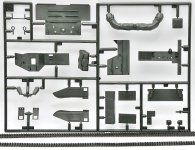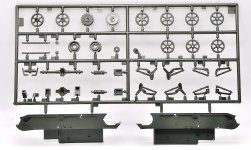paddy
Well-known member
This is Tamiyas old kit of the Universal Carrier or Bren gun carrier.
Its labelled as a European Campaign model however i am not sure how it differs from a North African campaign version as it includes figures in short sleeves, tin hats and shorts as well as European cold weather fatigues as well as North African 7th armoured brigade decals. It may be that the NA version is the same kit in a yellow plastic rather than this black......which i think may be a very dark green ?
This is a 1976 kit and seems to have been re-boxed as a reconnaissance and also a radio command version as well as this Bren gun version over the years







above is literally 10 minutes work but about as far a i can go without some painting. If you put the sides in the foreground on at this stage the interior will be hard to detail. this is a very simple kit, there are nearly as many parts to the 5 figures and their weapons as there are to the carrier itself so another speed build
cheers Paddy
Its labelled as a European Campaign model however i am not sure how it differs from a North African campaign version as it includes figures in short sleeves, tin hats and shorts as well as European cold weather fatigues as well as North African 7th armoured brigade decals. It may be that the NA version is the same kit in a yellow plastic rather than this black......which i think may be a very dark green ?
This is a 1976 kit and seems to have been re-boxed as a reconnaissance and also a radio command version as well as this Bren gun version over the years





above is literally 10 minutes work but about as far a i can go without some painting. If you put the sides in the foreground on at this stage the interior will be hard to detail. this is a very simple kit, there are nearly as many parts to the 5 figures and their weapons as there are to the carrier itself so another speed build
cheers Paddy
Last edited:



